26March: The End of the TUC March
Piccadilly, London. Saturday 26 March 2011

TUC marchers were still passing Piccadilly four hours
after the start of the march.
more pictures
I stayed around Piccadilly Circus while the rest of the TUC march came past me, its end marked by a large group of 'senior stewards' in pink hi-viz. The end of the march was much more varied and interesting than the early trade union dominated sections and it was good to see 'Rinky Dink' again - the bicycle powered sound system that I've photographed at various events over the years in London, Aldermaston and elsewhere.
After the official end, there were still other groups coming along the route
- including a group of Libyans with green flags, marching in support of Colonel
Gaddaffi. After photographing them I decided to walk down and see if anything
was happening in Trafalgar Square, but things were pretty quiet there and
so I took the tube and made my way home to wash off the paint.
more pictures
26March: UK Uncut Party & Protest
Oxford St & Regent St, London. Saturday 26 March 2011
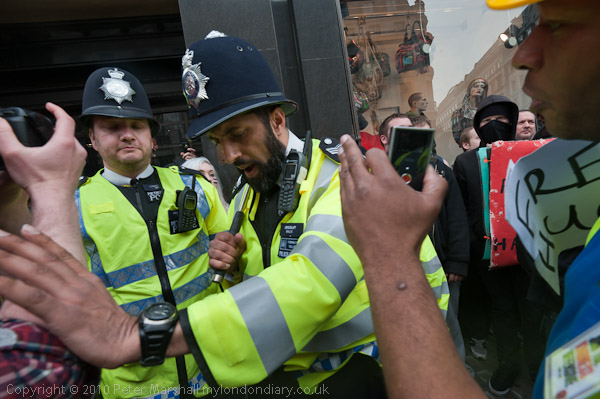
Policeman pushes protesters away and holds baton ready to strike
more pictures
UK Uncut supporters from around the country converged on Oxford St to hold peaceful protests at tax dodging shops and banks around Oxford St and to party at Oxford Circus. London, UK. 26/03/2011
While a larger group of people was watching a string of comic performers organised by UK Uncut in Soho Square, others were making their way in small groups along Oxford St to protest peacefully inside and outside the stores owned by Philip Green's Arcadia group, Vodaphone, HMV and banks, all accused of avoiding or evading tax.
The Trojan Horse of the 'Armed Wing of the TUC' had made its way to centre of Oxford Circus and was surrounded by people having picnics, and at one edge of the densely packed junction some people were dancing to a sound system. Soon they were joined by a samba band coming up Oxford St.
There was now there was a strong line of police protecting Top Shop, but few of the more serious anarchists remained around and many of the protesters were in fancy dress of various styles and the mood was by now largely festive. There were big cheers when it was announced that protesters had entered the Ritz.
I then saw a crowd beginning to go down Regent Street to join in the actions taking place on Piccadilly and followed them. It was a very mixed group including protesters dressed as clowns and some with badges calling on us to 'Join the Kindness Offensive' as well as many others.
Some way down the street they stopped at a doorway protected by three police and surrounded them, saying that the police were being kettled and asking them how they liked being treated this way. There were no physical attacks on the police, although some of the teasing and shouting from protesters was fairly aggressive, but the mood changed when when one of the officers, who had been calling for reinforcements, drew his baton and began threatening people, and pushing them away.
It seemed an over-reaction as the protesters had not made any real threat of violence, but the officer perhaps felt need to try and assert his authority; fortunately the crowd did not retaliate physically and more officers quickly arrived and the situation was defused.
As the group made its way further down Regent Street a convoy of a dozen or more police vans with sirens blaring came up on the other side of the road. The protesters immediately moved over to block their passage and they halted, with a dozen or so officers in riot gear starting to push people around and order them to clear the road. Which, after quite a deal of argument, they did.
We reached Piccadilly Circus at 4pm and I stopped there to photograph the
official TUC march, still coming past over four hours after it had begun.
I was beginning to think I should go home and get rid of more of the paint
over me and didn't want to risk being caught up in the events taking place
down Picadilly.
more pictures
26 March: Black Bloc Goes To Oxford St
Trafalgar Square, London. Sat 26 March 2011
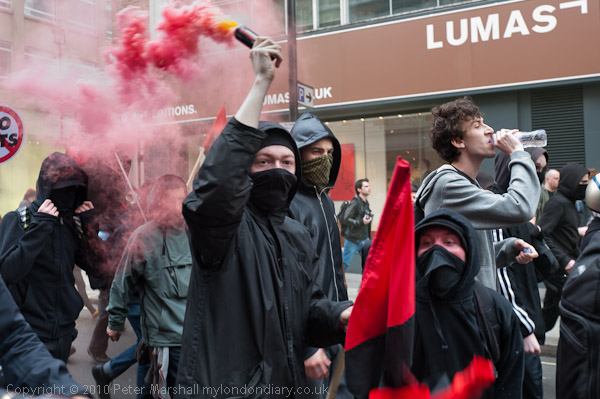
A number of coloured flares were set of as the bloc walked through the centre
of London
more pictures
The Black Bloc, mainly anarchist protesters, walked and ran from Trafalgar Square to Bond St and Oxford St where they smashed a few windows and threw paint and flares at shops of banks and companies avoiding paying UK taxes, including the RBS and Topshop.
While I was watching protesters in Trafalgar Square I saw a group of several hundred anarchists, dress in black and mainly wearing face masks making their way up past the National Portrait Gallery, many waving red and black flags.
I rushed across and went with them as they took a slightly wandering route through some of the back streets to Piccadilly Circus. Police made a half-hearted attempt to stop them as they surged up Regent Street but there were far to police to have any effect. The first of a number of coloured flares was lit here, producing some dense yellow smoke.
Half way up Regent St the group turned down Conduit Street and into Mayfair, where a few flares were let off, and on Bond St there was the first of several attacks on businesses, but a group of around 20 police prevented any damage to the RBS branch there, although some paint was thrown at the police and some hit an adjoining building.
The group then turned along Oxford St towards Oxford Circus, stopping outside Topshop, where some of the doors were smashed and more paint thrown.
I moved in to take photographs as police arrested one of the protesters, holding him on the ground, and was hit full on the chest by a paint-bomb possibly aimed at the police, although many of the protesters also have an irrational fear of photographers. My cameras were still working and I continued to photograph, but I had also become a subject for the other photographers.
As the black bloc moved away down Oxford St I made for a nearby public toilet,
where I spent some 20 minutes wiping off the worst of the yellow paint from
my clothes and cameras before going out to photograph the peaceful protests
of UK Uncut.
more pictures
26 March: Dancing in Trafalgar Square
Trafalgar Square, London. Sat 26 March 2011
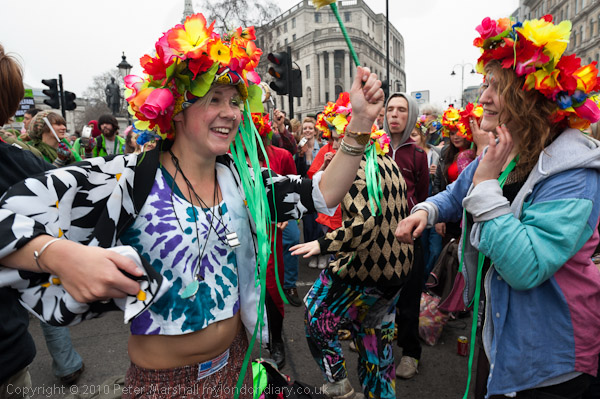
Dancing to the samba band in Trafalgar Square
more pictures
Although later in the day Trafalgar Square was the site of bitter fighting as police made a largely unprovoked attack on a partying crowd, earlier in the day everything was much more peaceful. As the half million or so TUC marchers made there way along the southern edge tourists wandered as normal and there was some extra entertainment for them.
When I first arrived, a Morris side was dancing in the centre of the square in traditional costumes, but it was a mixed side, unusual in such circles, and on looking more closely I noted from there badges that this was the Morris Liberation Front, an idea of Henry Flitton specially for the TUC demonstration, and the music, provided by a couple of mandolins was the Clash's 'I fought the Law' and the Smith's 'Panic.
When I returned later, the square was filled by the more robust beats of
a street band, with Matt directing and another friend from Sheffield, Dave
beating a large drum. Then they marched into the roadway where they were joined
by a team of flower-decked dancers.
more pictures
26 March: TUC March - Midday
Trafalgar Square, London. Sat 26 March 2011
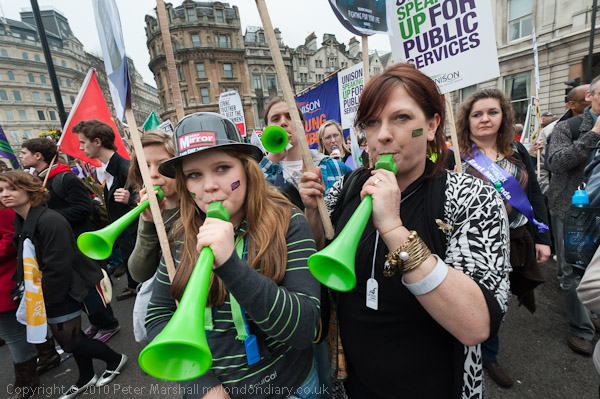 The
march got very noisy at times
The
march got very noisy at times
more pictures
I thought I would be in plenty of time to photograph the front of the march as it came up Whitehall when I arrived at Trafalgar Square shortly before noon, but it had obviously started earlier than I had been told, and the front was already out of sight on its way towards the rally at Hyde Park.
I watched people marching past for around an hour, taking pictures around
Trafalgar Square where it was a little less crowded than in Whitehall, then
decided I'd done enough and went back into Trafalgar Square.
more pictures
26March: South London Feeder March
Kennington Park, London. Sat 26 March 2011
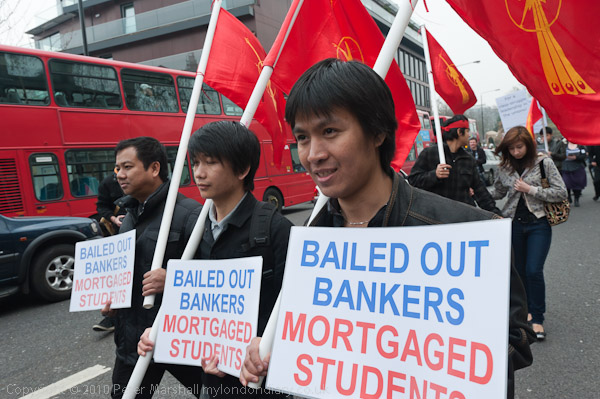
Bailed out Bankers, Mortaged Students - carrying Burmese
freedom flags
more pictures
Union branches with other groups in South London held a rally in Kennington Park and together marched from there to join the main TUC 'March For The Alternative'.
Although the TUC had advised people that there were no official 'feeder marches' to join their main march and that people should go directly to the Embankment, several feeders had been organised by union branches and others, including a 'South London feeder march' from Kennington Park organised by local unions and SOS, Southwark's Save Our Services campaign.
The starting point is one with great significance for the Labour Movement, for it was in this park - then Kennington Common' that the Chartists held their final "monster meeting" on 10th April 1848, attended by around 25,000 supporters before presenting their final petition to Parliament.
The park is also in the London Borough of Lambeth, which in 1984 under the leadership of Ted Knight was one of two councils to defy the Conservative governments order to cut services by refusing to set a budget - and which ended with him and the other councillors being required to pay a surcharge and being banned from holding any council office for five years. Knight was the final speaker at the rally before the start of the march, and when introduced got a great round of applause. Others speaking included several trade unionists, Lee Jasper of BARAC (Black Activists Rising Against Cuts), Chris Knight, dismissed by the University of East London for his political activities realted to the 2009 G20 protests, and Councillor Kingsley Adams, thrown out of the Labour group for opposing the cuts in Lambeth.
As well as the Lambeth and Southwark branches of the major public service unions, there were many community organisations taking part, including those very much under threat from the cuts, including nurseries and Brixton Belly Dancers. The area's large Latin-American community was also well represented.
Other groups that chose to join this march included BARAC , Solidarity Federation
groups of anarchists from North and South London, Liverpool and Sheffield
and the 'Armed Wing of the TUC' who had earlier marched from Camberwell.
more pictures
26March: Armed Wing of the TUC
Camberwell Green to Kennington Park, London. Sat 26 March 2011

The TUC Armed Wing arrive in Kennington
more pictures
The 'Armed Wing of the TUC' brought its Trojan Horse, Spitfire, Tank and armed Lollipop Ladies to Camberwell Green from where they marched to Kennington to join the South London feeder to the TUC March for the Alternative.
The arms are not of course real, and the rather impressive Trojan Horse and other armaments were produced by art students at Camberwell with the help of Chris Knight, the professor from East London University who was sacked when his employers failed to have any sense of humour over his comments on stringing up bankers from lamp posts.
This was of course political theatre aimed at illustrating and promoting radical thought rather than a call to practical action, and the event at Bank also introduced the Four Horsemen of the Apocalypse to the British political scene - and they too were part of the procession that made its way from Camberwell to Kennington, led by the tank and Spitfire with a large banner behind them proclaiming 'Capitalism Isn't Working', based on a Tory poster about Labour with a long queue of the jobless, and with the tag line 'Another World is Possible.'
The Trojan Horse refers both to the ancient myth, and to David Low (later Sir David Low's) cartoon depictions of the TUC in the Manchester Guardian from the late 1940s where he showed it as a rather slow and stubborn cart horse.
Theatre often has a serious message, and this intervention which included a nicely produced 4 side A4 publication, Worker's Militia (complete with the logo and a message of support supposedly from the Police Federation along with other activist groups such as UK Uncut) as well as the 'Battle of Britain' web site, was aimed at pointing out the spinelessness of the official TUC response to the cuts. To put it simply, the message is that we really should be up in arms about the government's actions.
For many trade unionists and most activists the TUC has been far too slow to act in opposing the cuts - they argue that this first national demonstration could have taken place in November - and also far too half-hearted in its official responses.
Chris Knight gave a powerful speech at the Kennington rally before the South London feeder march moved off to join the main TUC event. The Trojan Horse later made its way to Oxford Circus, becoming the centre of events there, also the subject of another feature.more pictures
University And College Lecturers March
Aldwych, London. Thursday 24 March 2011
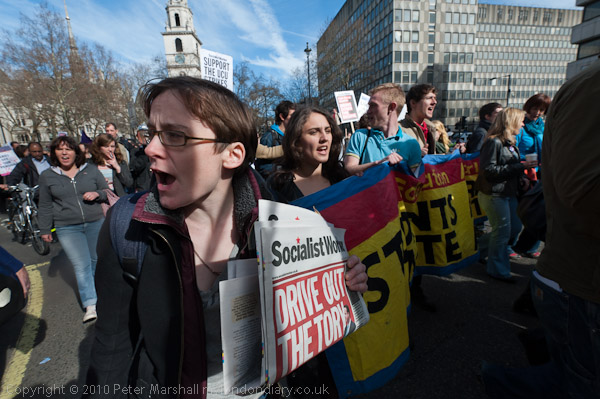
The march swings round into Aldwych southside
more pictures
University and college lecturers from the London region marched from the LSE to Parliament today in a protest over pensions, jobs and pay. College and univiersity lecturers have received derisive pay offers this year and last year, which taking into accout inflation mean a cut in real wages of around 8-10%.
There are threats of up to 40,000 job losses in higher education, with cuts in funding, while large rises in fees seem certain to deter many students from less wealthy backgrounds.
Lecturers are generally still greatly underpaid compared to those with similar qualifications working in private industry, and the pensions are considerably less generous than the lies spread by the government imply - they are certainly not 'gold plated.'
Lecturers were on strike today, and there were a number of demonstrations and events around the country as well as picket lines outside colleges. The UCU London Region organised a march to Parliament, starting from the LSE in Aldwych with around a thousand people taking part.
After the march there was a rally at the Emmanuel Centre in Marsham Street,
close to Parliament which I did not attend.
more pictures
Libyans Congratulate Cameron Over No-Fly Zone
Downing St, London. Thursday 24 March 2011
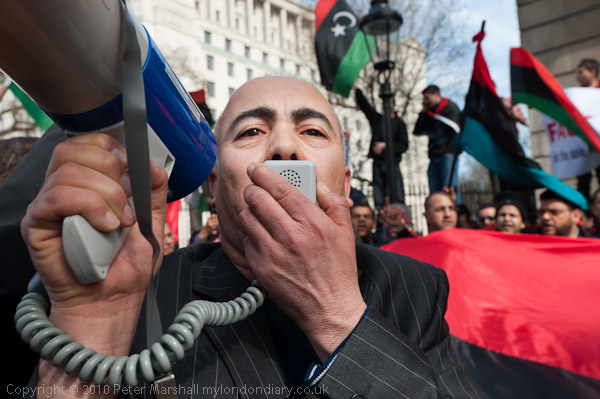
Libyans chant praise for Cameron prodding the UN into action
more pictures
Around 500 Libyans supporting the revolution there came to Downing St this lunchtime to express their thanks to David Cameron for the air strikes against Gaddaffi's forces and his leadership in establishing a 'no-fly'zone.
Unlike the British left, most Libyans living in the UK appear to be strongly in support of the military actions taken in the past few days by Britain, France and the US against Gaddaffi's air defences and army.
They beleive that these actions were necessary in the short term to prevent a bloodbath with the dictator's armed forces close to taking over Benghazi and other towns held by the Libyan people.
They shouted loudly together in English "David Cameron, Thank You Very Much" and other similar slogans in a high-sprited demonstration with much flag waving. At one time I was underneath a giant red black and green flag held horizontally and being waved by around thirty men. Others crowded around or stood on nearby walls with banners and flags.
The main banner was also in English: 'FACT: The Interim Transitional National Council is the sole legitimate representative of the Libyan people'. This followed the statement by the council, which was formed on 27 Feb and on 5 March declared itself the "sole Representative of all Libya" and the setting up of an interim government by the council on 23 March.
On 10 March, France begame the first major European power to recognise the National Council and Britain and France issued a joint statment on 10 March calling on Europe to recognise it, and on 12 March Lebanon’s Parliament Speaker Nabih Berri demanded that all Arab governments should give immediate recognition to the Libyan National Council.
Next to the men were a smaller group of women and children also taking part
in the demonstration, and a few yards further on a single man with two large
placards was showing support for Gadaffi andcalling on Britain to keep out
of Libya.
more pictures
ESOL Day of Action
Old Palace Yard & Downing St, London. Thursday 24 March 2011
ESOL students and tutors crowd outside Downing St
more pictures
ESOL students and teachers from colleges across London came to protest at Westminster over cuts to courses which give essential English language skills to speakers of other langauges.
Several hundred ESOL (English for Speakers of Other Languages) students and tutors from colleges across London, including Lambeth, Hackney, Barnet, Tower Hamlets and Greenwich came together in Old Palace Yard opposite the Houses of Parliament for workshops and a rally this morning.
Many of the students spoke at the rally, saying how essential these courses were to them, offering them the chance to learn English and then get jobs - and pay taxes. Most were able to speak in English, proving the success of their courses, although a few needed the help of translators. Most too had learnt the essential English chants for marches against education cuts and put them to good use, with "No ifs, no buts, No education cuts!', 'Students and workers, Unite and fight!' and the rest sounding loud and clear towards Parliament and later at Downing St.
Other events in the ESOL day of action were taking place across the country, in Birmingham, Brighton, Bristol, Halifax, Leeds, Newcastle, Nottingham, Rochdale, Sheffield and Warwickshire.
At 1pm, the protesters walked down to demonstrate outside the gates to Downing Street while a small group took a letter to the Prime Minister.
The Action for ESOL web site states:
ESOL is the main publicly funded English language provision in the UK, and provides an essential service to many asylum seekers and refugees. ESOL is essential for integrating refugees into the community here and enabling them to contribute fully to British society.
The coalition government intends to severely limit free places on ESOL courses and end funding for ESOL courses in the workplace, as well as reducing funding all round by 4.3%. The changes would mean an estimated 70% of current ESOL students being unable to study, with a corresponding closure of courses. They would have a particularly high impact on women who make up the majority of those taking the courses.
After the demonstration at Downing St some of the ESOL students and teachers
intended to support the UCU (University and College Union) London Region Rally
being held in Westminster later in the afternoon.
more pictures
Budget Day Cuts Protest
Trafalgar Square and Whitehall, London. Wed 23 March 2011

The march sets off for Downing Street from Trafalgar Square
more pictures
The Right to Work campaign planned several demonstrations on Budget Day against the cuts, including a march from Trafalgar Square to a rally at Downing St, organised together with the Coalition of Resistance and supported by Stop the War, Labour Representation Committee, CND & DPAC which also protested against the attacks on Libya.
Government ministers Eric Pickles, Secretary of State for Communities and Local Government and Health Minister Andrew Lansley called off their engagements in London earlier on Budget day where Right to Work had planned to hold protests, but the Budget Day 'March to Downing Street' in the early evening took place as planned, although members of the government kept well out of the way.
Around two hundred activists gathered in Trafalgar Square at 5pm for the march, although a few left before it made its way down Whitehall to the pen opposite Downing St for a rally.
Speakers there largely dismissed the budget as irrelevant to the real issues facing the country, in particular the savage cuts in public expenditure and public services already announced by the government. This was only a small demonstration, but as several said, the real protest will be on Saturday, when millions are expected on the streets of London, with many expected to stay on after the march in Hyde Park, Trafalgar Square and elsewhere.
But even the mass turnout on Saturday is only the start of the fight against the cuts, which will continue, as National Shop Stewards leader Rob Williams put it "library by library." Others, including Paul Mackney praised the example shown by the students in their demonstrations in November and Decemberand called on the trade unions to follow their example.
Stephen Hester the Prospect rep for Health and Safety Inspectors warned of the changes in this area announced as a part of the cost savings and stimulus to industry, which will mean a complete end to Health and Safety inspections of most workplaces, taking working conditions back many years.
We were also reminded of the particular threat posed by the cuts to the disabled by Eleanor Lisney from DPAC (Disabled People Against Cuts) who spoke from her wheelchair, and said that although many disabled would join the protest on Saturday, others whose disability prevented them from being physically present would also be taking part from where they could be, making their protest at locations on a map which would be on the web.
As well as the cuts, there was also condemnation of the continuing attacks
on Libya, which appeared very much to be a continued neo-colonialist attempt
to retain control of Libya's oil resources. Lindsey German of Stop
the War made a typically powerful attack on the policy of our and other western
governments, and Kate Hudson of CND reminded us of the enormous expense
involved, which Geoarge Osborne confirmed in his speech will come from general
taxation and not the military budget, resulting in a need for even deeper
cuts. One enormous financial saving could be made by the cancellation of the
Trident replacement, a project for which there is no military justification,
but which is simply a matter of political dogma.
more pictures
Hands Off Libya
Whitehall, London. Sunday 20 March 2011
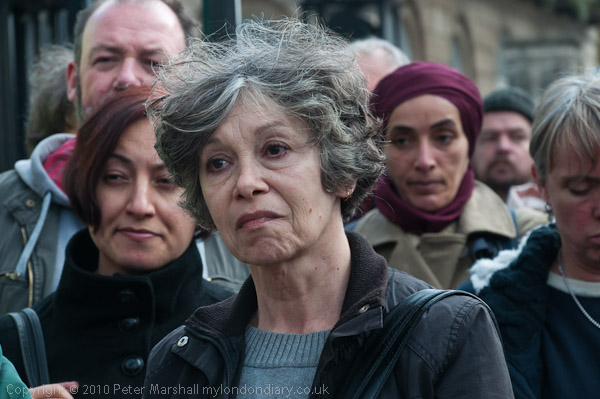
People listening to the speeches
more pictures
Stop The War organised a further protest against the British military intervention in Libya, which they see as an attempt to impose western interests and are convinced will escalate.
Although the intervention to create a no-fly zone had the support of the Arab League and the unanimous authorisation of the UN Security Council, Stop the War and the other organisations taking part in this demonstration, which included the Communist Party of Greece (KKE), the Communist Party of Great Britain (Marxist-Leninist) and Socialist Workers see this as the latest efforts of an imperialist west to maintain profitable access to Libya's oil reserves.
They see the Arab League as dominated by reactionary regimes trying to maintain their own status quo and to be colluding with the western powers to bring an end to the Arab revolutions across the area.
Stop The War are undoubtedly correct to point out the danger of escalation of the current conflict and may well be right when they sugeest that 'The imposition of a "no-fly zone", air attacks on Libyan defences and Gaddaffi's tropps, and naval bombardments will not bring preace to Libya nor a resolution to the conflict there'. There was too a certain piquancy to the fact that this protest was taking place on the day following the 8th anniversary of the invasion of Iraq.
Around a couple of hundred turned up to hear speeches condemning the attacks by Jeremy Corbyn, MP, Kate Hudson of CND, George Galloway and Lindsey German of Stop the War.
I was left unclear by about how those speaking felt that support should have been given to the people of Libya - and the CPGB-ML were certainly supporting Gaddaffi and suggesting that the Libyans opposed to his regime were the stooges of imperialism, while others were clearly supporting them along with the other Arab revolutionaries.
Stop the War "believes that there should be no external military intervention in Libya. In supporting the Arab revolutions, we believe that these will be strangled, not supported, by western military action." But until the air strikes it looked almost certain that the revolution in Libya was very close to military defeat by Gaddaffi's forces, and bloody massacres of the civilian opposition seemed inevitable.
Stop the War also state: "We call on the British government to keep
its hands off the Middle East and demand that it refrain from all involvement
in military action in Libya or elsewhere in the region. We urge the anti-war
movement to campaign throughout the country to arrest and reverse this slide
to war and British participation in it."
more pictures
Vigil For Fukushima - No New Nuclear for UK
Whitehall, London. Sunday 20 March 2011
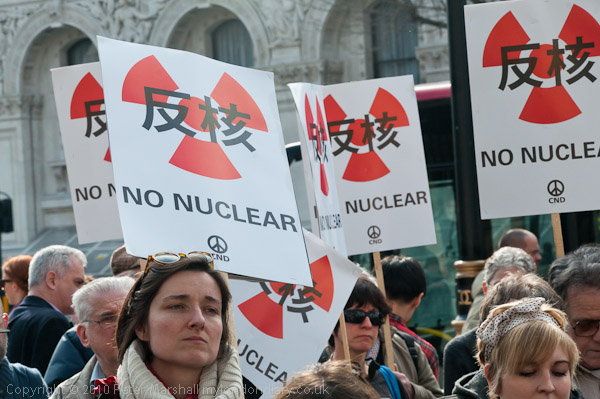
A crowd opposite Downing St listens as the health issues
around nuclear power are explained
more pictures
A CND organised vigil in Whitehall expressed sympathy for the Japanese people affected by the crisis at the nuclear plant at Fukushima and called for no new nuclear power in the UK.
CND is opposed to nuclear power and the dangers that it represents, particularly in terms of radiation leaks and the long term dangers of the spent fuel with its long half-life isotopes. As one speaker said at the event today, if the Roman ruins across our countryside had been nuclear plants, rather than tourist attractions these sites would still be dangerous and banned locations.
Several hundred people turned up at Downing St (and there have been other similar protests in Manchester, Plymouth and elsewhere) to express their sympathy for people close to the reactors in Japan, and in particular the workers in the plant who have been subjected to dangerous radiation levels as they have struggled to contain the problems caused by the earthquake and tsunami.
Among the speakers was a medical expert on the effects of radiation, and in a long address she commented "It is the health evidence that should be the loudest warning for the nuclear power industry... this is probably why the research has so frequently been contested, undermained and sometimes suppressed."
Talking about the aftermath of Chernobyl she quoted a report from the International Atomic Energy Agency in 2005 that stated 'The cancer and death rate studies that have been conducted among samples of the recorded liquidators (those who dealt with the plant after the disaster) have shown no direct correlation between radiation exposure at Chernobyl and increased cancer or death rates.' However the Chief Medical Officer of the Russian Federation had reported four years earlier that 10% of the 184,000 people involved had already died and one third were invalided.
Other speakers at the Vigil included Jeremy Corbyn MP and Kate Hudson, Chair of CND. Before the speeches there was a minute's silence for those killed by the earthquake and tsunami.
It is clearly time to abandon the experiment with power from nuclear fission; hopes were high in the 1950s that it would lead to cheap and abundant power, but now we know that this was a pipe dream and the reality is very different. Already we have created a legacy that will be a curse civilisation for as long as it exists on this planet.
The future has to be renewable energy, and speakers urged the UK Government
to direct its energy investment towards this rather than build up more problems
for the future in a nuclear programme.
more pictures
Don't Make Compassion Criminal
Westminster Cathedral, London, Sunday 20 March 2011
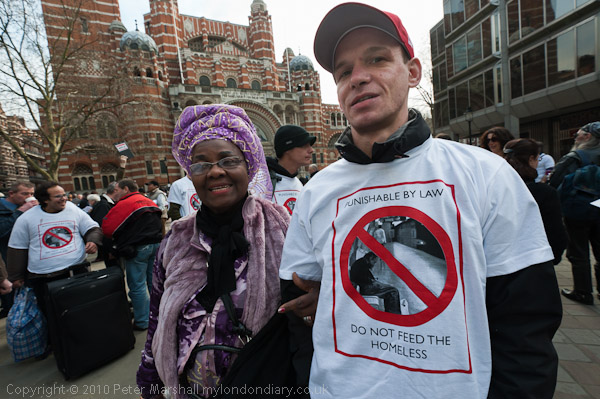
This woman told me they could not stop her taking her friends form the street
to MacDonalds
more pictures
A Flashmob and street party on Westminster Cathedral Plaza gave out free food to the homeless and opposed Westminster City Council's plan to criminalise rough sleeping and the giving of food and friendship to the homeless.
Westminster City Council are proposing a bye-law that would arrest and impose fines of up to £500 on both anyone sleeping rough and on anyone giving food to those in need. It seems to be a direct attack on those with least in our society, as well as on one of the basic principles that underlies all our major religions and indeed basic humanity, that of caring for those in need.
Charity workers and volunteers say that Westminster's claim that there are hostel places for all those on the streets is simply false and there are not enough beds. They also say that many find hostels very threatening places and that some people need time and sympathetic handling to be persuaded inside them.
The council assert that the homeless are on the streets because soup runs give out free food. Rough sleeping is never a comfortable option, but one to which people are forced by circumstances, and their suggestion reveals a total lack of understanding of the problems faced by those at the bottom of our society, and the kind of insulation from human feelings that too often seems to inflict some of the rich and comfortable.
The campaign against the proposed byelaw is supported by many groups including Housing Justice, The Methodist Church, the Pavement, the London Soup Run Forum, the Simon Community and Zacchaeus 2000. Those at the 'Party Against Criminalising Compassion' were urged to look at the consultation documnets on the Housing Justice or Pavement web sites and send their responses to Westminster Council before the end of the consultation period on 25 March.
The flashmob and street party was organised by the 'Sock Mob', "a group of friends engaging with the homeless in London by cutting through the misconceptions, prejudice and fear that often accompany stereotypes of rough sleepers and other vulnerable groups in the city ... driven by the ethos of unconditional human contact and friendship" and supported by Housing Justice, The Simon Community, Coombe Trust, Street Souls, The Pavement, Open Cinema, Apricots and More, Streetlytes and many other groups. (The Sock Mob's name comes from the fact that many of those living on the streets need socks and other clothing as well as food, and this group regularly comes to hand these out to the homeless.) It began with a Flashmob outside the nearby offices of the department for Communities and Local Government at Eland House in Bressenden Place where a number of people staged a 'die in' to the accompaniment of Radiohead's 'Just'.
People then went along to the Cathedral plaza, where trestle tables were set up and piled with food which was given out free to all those who wanted it, including a number of rough sleepers from the plaza and surrounding areas. Many of those who offer friendship and food to the homeless in Westminster were there for the event, and some were clearly intending to continue their Christian charity whatever the law.
After the event had been running for some time, and many people had benefited
from the very tasty looking stew, sandwiches, soft drinks and other foods
being given out, there was a repeat of the Flashmob on the Cathedral plaza.
more pictures
Repeal Pakistan Blasphemy Laws
Downing St, London. Saturday 19 March 2011

The event paid tribute to Minister Shabbaz Bhatti, assasinated this month
for his opposition to blasphemy laws
more pictures
UK Asian Christians held a protest at Downing St in tribute to Minister Shabbaz Bhatti, murdered in Pakistan for upholding minority rights and opposing the blasphemy law, and calling for an end of the unjust Blasphemy Law and the killing of Christians and injustice related to it in Pakistan. London, UK. 19/03/2011
The protest was organised by Christian Social Link, a UK based human rights organization founded in 2004 and serving mainly the Christian community living in the UK or Pakistan, and had been going for several hours when I arrived to find a large group of mainly British Asian Christians still making their voices heard. Among groups supporting the event was the AAECA, the Asian, African and European Christian Alliance co-ordinated by Pakistani Christian Daniel Farman.
Shahbaz Bhatti, the Federal Minister for Minorites in the Government of Pakistan and the only Christian minister in the government was killed by Muslim extremists on 2 March 2011 because of his opposition to some sections of the blasphemy laws. His death followed that of Punjab governor Salmaan Taseer, shot on 4 January 2011 by his own security guard because of his opposition to the blasphemy laws.
As well as these high-profile cases there have been many other Christians in Pakistan who have been victims of mob killings and imprisonments over false claims made under the blasphemy laws. Any accusation of blasphemy - which covers a wide range of activities - usually leads to harassment, threats and attacks and those accused usually have to be kept in solitary confinement for their own protection, and even if acquitted have to either leave Pakistan or go into hiding.
The protesters called on the Government of Pakistan to provide proper protection
for all its citizens and to ensure effective justice and punishment for those
instigating and taking part in mob violence against Christians, as well as
for the repeal of the unjust blasphemy laws. In particular there were calls
for the repeal of Article 295C which forbids defaming on the prophet Muhammad,
which is an offence event if unintentional, and must be tried in a court under
a Muslim judge. They also called for the release of Asia Bibi and all others
who are in jail in false blasphemy cases.
more pictures
Hare Krishna Celebrate Gaura Purnima
Soho Square, London. Saturday 19 March 2011
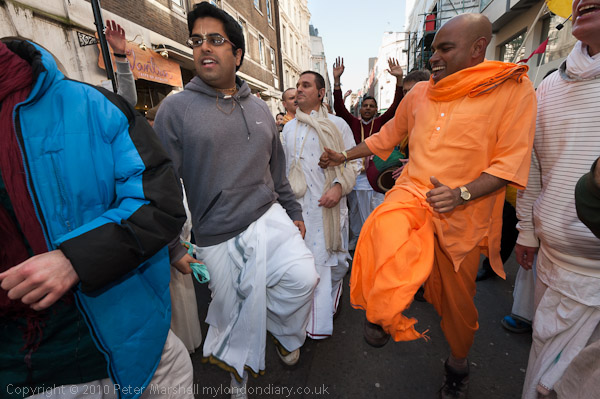
Dancing in the road in front of the chariot
more pictures
Hare Krishna around the world celebrated the Guara Purnima Festival on March 19, celebrating the appearance of the 'Golden Avatar' who began the chanting of Hare Krishna.
Sri Chaitanya Mahaprabhu (1486-1534), also known as Lord Chaitanya, lived in West Bengal and devoted his life to showing to the world the love of Krishna and his teaching. Revered as an incarnation of Krishna and Radha he taught a simple method of pure devotion through dancing, feasting and the simple chanting of the Krishna's holy names, and the Hare Krishna Maha mantra:
Hare Krishna Hare Krishna Krishna Krishna Hare Hare
Hare Rama Hare Rama Rama Rama Hare Hare
It was his example that inspired the founder of the International Society for Krishna Consciousness (ISKCON), His Divine Grace A.C. Bhaktivedanta Swami Prabhupada. The Hare Krishna movement came to London in 1967, gaining popularity through the support of George Harrison, and have become a regular sight on the streets here, chanting and distributing free food.
During the celebrations they paraded an effigy of Swami Prabhupada from their
temple around Soho Square, dancing and chanting for an hour or more on Saturday
afternoon.
more pictures
Ahava Boycott Protests Continue
Monmouth St, London. Saturday 19 March 2011

Demonstrators calling for the boycott of Ahava
more pictures
Protesters continue their regular bi-weekly protests calling for a boycott of Ahava products outside the Israeli company's shop in Covent Garden.
Ahava is targeted by protesters because they have a factory and visitor centre in Mitzpe Shalem near the Dead Sea, an illegal Israeli settlement on the occupied Palestinian West Bank.
Since 1967, over 260,000 Israeli settlers have moved into the Occupied Palestinian Territories in defiance of international law and UN resolutions, with over 40% of West Bank land being lost to the illegal settlements.
The settlements make the daily life of Palestinians near to impossible with incidents of violence from armed settlers, and their movements are restricted by hundreds of checkpoints and the 'Apartheid Wall.' The settlers have also diverted scarce water resources for homes and irrigation, while Palestinian farmers often lose crops from lack of water.
The protesters also claim that Ahava fraudulently labels products made in the settlements as Israeli produce, enabling them to benefit from customs duty exemptions under the EU-Israel Trade Agreement.
The campaign to boycott Ahava products - also sold by a range of UK companies including John Lewis - is supported by the Palestine Solidarity Campaign and Jews for Boycotting Israeli Goods (JBIG) who want the British government to ban all Israeli settlement produce. They also campaign for a boycott of all Israeli goods "until Israel anides by international law and respects human rights."
Also outside Ahava was a smaller counter-demonstration with around half a dozen activists. I listened with disbelief as one of them explained to passers-by how Israel was fighting for its existence against Palestinians who were not prepared to make any compromises short of the complete expulsion of all Jews from Palestine. Given the widely leaked documents about the peace negotiations in which the Palestinians offered huge compromises but were rebuffed by Israeli intransigence it was a clear distortion of the truth.
Israel's claims to democracy which they also stressed clearly do not apply to Palestinians in Israel or the occupied territories or even anti-zionist Jews in Israel. Currently some of Israel's best-known Human Rights organisations are being subject to investigations for having criticised Israeli policies. It's had not to think of Israel in terms of Apartheid, although perhaps surprising that both groups of demonstrators used that term. Despite their differences, there were also people in both groups wearing a sticker supporting a two state solution to the conflict.
The last time I photographed one of these regular demonstrations, the majority
of those opposing the boycott were people I recognised from EDL demonstrations,
including several who said they belonged to the EDL's Jewish Devision. I saw
none of these at this later protest.
more pictures
St Patrick's Day Parade in Brent
Willesden Green, London. Thursday 17 March 2011

People came out on the streets to watch the procession
more pictures
St Patrick led a parade today from Willesden Green station to an Irish festival at Willesden Green library. Following him were the mayor and community leaders, a marching band and groups from Irish organisations as well as local schoolchildren.
The place to be in London on St Patrick's Day is Willesden Green where for some years community groups with the support of the London Borough of Brent have held an Irish festival including a community parade through the main streets. Although some years ago the then Mayor of London Ken Livingstone introduced a London St Patrick's Parade and Festival on the Sunday nearest to the day, the Brent parade is the only major one on the day itself.
Brent is one of London's more culturally diverse boroughs, and one that has supported the celebration of this diversity through the celebration of various community festivals including this, encouraging people from all communities to take part and learn about each other's cultures. Activities such as these are unfortunately now at risk; despite talk of the 'Big Society' the kind of little activities that would underpin this are being killed by the cuts, and this could be the last St Patrick's Day parade in Brent.
People lined the streets and waved Irish flags, cheered and applauded as the Birmingham Irish marching band followed St Patrick and the Mayor of Brent with community leaders along the route. Behind them were various Irish community and youth groups, some in lorries and others on foot, along with a group of schoolchildren in green and white carnival costumes (a reminder perhaps that Notting Hill is just a mile or two down the road.)
As the parade came close to the library the streets became more and more
crowded, with of those watching joining in the procession. Many had come specially
to watch the procession, while others had already been celebrating St Patrick's
Day in several pubs and bars along the street, and others came out so shops
to watch. After the procession the Birmingham Irish band, played a couple
more tunes in the area in front of the stage. I left after this and before
the speeches by the Mayor and other distinguished guests and a programme of
Irish music and dancing.
more pictures
London Violet People Oppose Berlusconi
Downing St, London. Sat 12 March 2011

It took me a while to work out what this Italian protest was about but then
I realised they were anti-Berlusconi
more pictures
Italians living in London held a protest to defend the Italian constitution from attacks by Silvio Berlusconi's government with a rally at Downing Street before marching to the Italian Embassy.
By the time I left there were around a hundred people listening to speeches at the rally on Whitehall in a protest organised by Il Popolo Viola of London, part of the Italian politically independent grass-root movement created by independent bloggers which organised one of the largest demonstrations of the last decade in Italy, the 'No-Berlusconi Day' in December 2009, bringing, according to some estimates a million protesters to Rome, with other protests around Italy and the globe - and in London on that day there were 500 protesters.
Many at today's protest were wearing violet scarves to show their support of Il Popolo Viola. One of the other groups involved, appropriately since International Women's Day was being celebrate this week, was Donne Pensanti (Women's Thinking) and a majority of those speaking while I was present were women. Unfortunately as all the speeches were in Italian I was able to follow very little of what was said.
The protest attracted some attention from the many tourists who were strolling along the street, particularly the Italians, some of whom stopped for a while to listen to what was happening.
The Italian constitution was produced with the cooperation of the main political parties - the Christian Democrats, Socialist and Communist parties- after the Second World War following the end of Fascism and aimed to establish a principle of equality that would be an effective antidote against any future authoritarian tendencies.
The constitution sets out the rights and duties of all citizens and expresses the core values of every democracy. The protesters see it as a duty to defend these rights, which for them express the "very spirit of Italy, of a united Italy."
They see the actions that Berlusconi is taking to ensure his impunity and promote his interests as a disfigurement and humiliation of their country and one against which they need to make a stand.
In particular they are taking to the streets to defend the Article 21 rights to freedom of information and expression, the Art. 34 right to a public education for all and the rights to liberty and equality without distinction of sex, race, language, religion or political orientation given by Art. 3. Displayed during the protest was Art. 4 which recognises the right to work and also of citizens to contribute to the material or spiritual progress of society.
I left before the end of the rally, when the protesters intended to march
to the Italian embassy in Grosvenor Square.
more pictures
Hands Off the Middle East
Downing St, London. Sat 12 March 2011
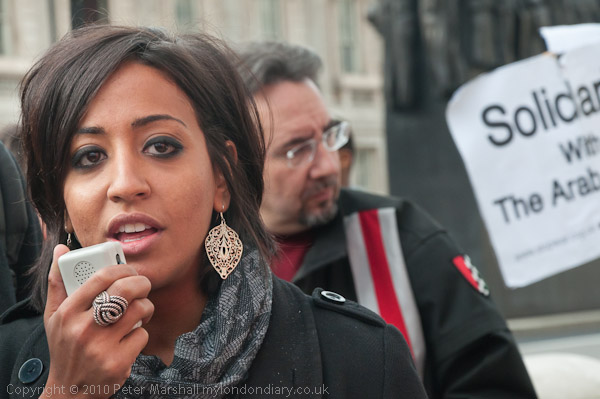
Egyptian socialist Gigi Ibrahim, who was in Tahrir Square for the Egyptian
revolution speaking at Downing St
more pictures
Stop the War activists around the country protested against western military intervention in Afghanistan and any proposed action, including a no-fly zone in Libya. In London they held a protest at Downing St, handing in a letter to the Prime Minister.
A little under a hundred protesters held banners and placards opposite Downing St on Saturday afternoon in a protest called at short notice to oppose the attempts to set up a no-fly zone in Libya.
There was a short rally, with speeches from Lindsey German of Stop the War, the vice chair of CND and Egyptian socialist Gigi Ibrahim, who had taken part in the recent Tahrir Square protests in Cairo that made a revolution in Egypt.
There were calls for western troops to be brought home from Afghanistan as well as outlining the dangers of any British or western involvement in Libya and other countries in the Middle East. Britain was highly compromised by its support of dictators such as Gadaffi and other rulers who denied civil rights to their people, and supplying them with arms and equipment enabling them to keep their people down.
A small group then took a letter across the road to hand in to No 10 Downing
St for Prime Minister David Cameron.
more pictures
Mothers March for Survival
Trafalgar Square to SOAS, London. Sat 12 March 2011
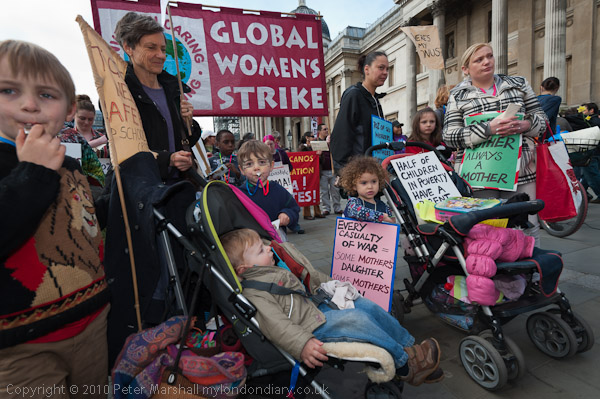
Mothers and children wait for the march to start
more pictures
Over two hundred women, men and children marched through London calling for an end to cuts, poverty and discrimination against women and others on the Saturday after International Womens Day.
The Mothers March For Everyone’s Survival & Welfare: End Cuts, Poverty & Discrimination gathered in front of the National Gallery in Trafalgar Square and was notable for the wide range of banners and placards as well as for the many mothers with children who were taking part.
Among those on the march were women who had come to the UK to claim asylum following torture and rape in their own countries. Much of the unrest that had caused their oppression was caused by wars often funded and promoted by various Western governments to gain access to natural resources such as oil, gold, diamonds and minerals. Western nations too make many of the weapons and sell them to the countries involved - British arms sales to Africa are now more than £1million a year.
Asylum seekers hear are treated unfairly, and the stories of survivors of masacres and rapes are often called "liars, bogus asylum seekers, economic migrants who only come looking for benefits." Women who have had to flee for their lives leaving children behind are not allowed to have their children join them. and children who are here have been treated very badly, often kept with women for long periods in detention.
Others protested about the effect that the cuts will have on poorer families. Placards in various languages, reflecting those of the people carrying them, called for looking after children to be regarded as work;
One of the many chants on the march made this clear:
Caring for a child is a Full time job!
Fighting for benefits is a Full time job!
Living on a pension is a Full time job!
Cleaning up Parliament is a Full time job!
Surviving rape and injustice is a Full time job!
Seeking asylum is a Full time job!
and others included
Deportation No Way!
Destitution No Way!
Stuck in Yarls Wood No Way!
MOthers and children are Here to stay!
and
No ifs, no buts
The kids won't take your cuts
No ifs, no buts
The mums won't take your cuts
No ifs, no buts
The dads won't take your cuts
The women organising this march have been organising marches to celebrate International Womens Day for some years - I first photographed their march in 2002. I was sorry not to be able to stay to the rally at the end of the march at SOAS in the University of London, when distinguished campaigner and author Selma James was speaking on International Women's Day: how rapidly things change, and there was to be a report from a trade unionist about the movement against the cuts in Wisconsin, USA.
This march was one of a number around the globe organised as a part of the
Global Womens Strike movement, with other events in Guyana, Haiti,
India, Italy, Peru, Poland, Venezuela and four across the USA.
more pictures
Free Tibet March
Westminster, London. Sat 12 March 2011

Tibetans have No Voice in Tibet
more pictures
Approaching a thousand people, including many Tibetans, marched to Downing St and then on to the Chinese Embassy, in their annual commemoration of the 1959 Tibetan uprising, remembering the victims of the brutal repression of the 2008 protests and calling for a free Tibet.
Tibet became an empire around 1500 years ago but through the years had strong
links with China, at times being under Chinese domination and at others gaining
autonomy. In 1910 the Chinese invaded, deposed the Dalai Lama and established
direct rule, but in 1912 the newly formed Republic of China allowed the Dalai
Lama to set up an independent Tibet. But in 1950, the Poeple's Liberation
Army New invaded Tibet and forced an agreement which re-established Chinese
sovereignty but allowed Tibet autonomy under Chinese control.
Following the 1959 Tibetan uprising, in which 87,000 Tibetans were killed, the Dalai Lama and his government fled to India and China took over the country implementing social and political reforms. Following the end of the cultural revolution in China there was some liberalisation of Chinese policies in Tibet, allowing freedom of religio and reubuilding monasteries. But by the end of the 1980s, following protests for independence, the Chinese administration clamped down on protests, often with brutal disregard for human rights, and halted the process of reform.
The marchers formed up by the side of Methodist Central Hall in Westminster, under the plaque commemorating the inaugural meeting of the General Assembly of the United Nations held there in 1946. Many of those taking part carried or wore the the Snow Lion or Free Tibet Flag. Used as the Tibetan army flag from 1912 to 1959, it was adopted by the Dalai Lama in exile as a unifying symbol for the country and is now the symbol of the Tibetan independence movement. It is banned in China and Tibet.
The march moved off past Westminster Abbey and through Parliament Square and then up Whitehall, where it halted outside 10 Downing Street, where a small deputation went in to deliver a letter to the Prime Minister calling for the British government to press for an end of human rights abuses in Tibet and to support the claim of the Tibetan people for freedom. I left them at this point to cover another event.
From there the march continued through the West End to the Chinese Embassy in Portland Place, where a short rally was held opposite the embassy.
The commemoration continued later with "an afternoon of Tibetan
dance, words, music and food to showcase and celebrate Tibet's unique culture"
in Westminster Cathedral Hall.
more pictures
Day X Defend the NHS
Royal London, Whitechapel to Bart's. Wed 9 March 2011
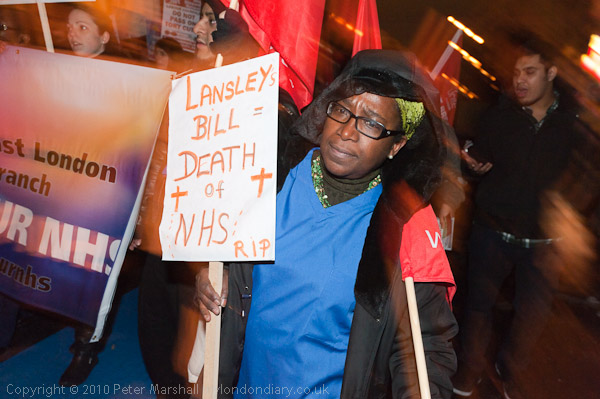
'Lansley's Bill = Death of NHS. RIP'
more pictures
More than a thousand people, including many hospital workers and medical
students, marched from the Royal London Hospital to Bart's in protest
at NHS cuts and the Health and Social Care bill which endangers the NHS and
its principles.
People gathered on the pavement and steps at the main entrance of the Royal London Hospital in Whitechapel at 5pm and there was a noisy rally with speaker after speaker from the health service, the health service unions and other concerned parties including patients. Some health workers came in their uniforms and many had made their own banners against the proposed slashing of services.
The cuts at Bart's and Royal London will mean the loss of 630 jobs and 100 beds, while at the same time the private company running the new PFI hospital will be paid £100 million.
As well as direct cuts in some areas of provision, the idea of allowing GPs to control 80% of the funding is likely to impact very negatively on the running of a comprehensive health service. GPs and the private services many will buy in to run their practices will be free to chose private providers, who can offer cut prices for simple operations in the knowledge that the NHS will deal with any complications that arise, as well as taking the more difficult cases to start with. Without the straightforward cases, the costs per case for the NHS will rise, making them even less competitive and may lead to services actually shutting down.
The NHS expects 50,000 job cuts across the country. The bill that the Lib-Con coalition is putting through parliament under health minister Andrew Lansley is a large and complicated measure which may well cost around £3 biillion and will effectively privatise almost 1 million NHS staff in England by 2014. It sets up an NHS Commissioning Board which will meet in private and be under no obligation to consult or even publish a proper rationale for closing hospitals and other major changes.
Although the bill claims to give the funding to GPs, their work will be controlled by the commissioning board, who for example will be selecting providers for the national register. Clinical services will be open to bids from "any willing provider" and if the bill becomes law we will see the same type of cost-cutting cowboys who took over hospital cleaning in the 1980s, cutting wages, hours and standards, resulting in filthy wards and infections such as MRSA becoming commonplace.
The bill will also reduce patient choice, with largely privately run "referral management teams" having to give approval to hospital referrals, with a mission to cut spending. Many health workers at all levels see the bill not as a reform but as a deliberate attempt to destroy the NHS, relegating it to a few minor functions and handing healthcare over to the private sector.
After a solid hour of speeches, the march, including a grim reaper and a coffin for the NHS set off into central London shortly after 6pm. As it past a large office of the RBS at Aldgate, a group of demonstrators rushed the outside area, up a short flight of steps from the pavement, and waved flags and banners, chanting "Bankers, bankers, what you going to do, what you going to do when we come for you" but despite the anger at those who caused the crisis which led to the public service cuts, the mood remained generally calm, positive and peaceful, with no attempt to enter the property or cause damage.
At Moorgate, hospital workers staged a short "die-in" in the middle of the road, but soon the march was up and moving again.
Later there was also a short period of shouting outside a Vodaphone shop in the city, "Pay Your Taxes!" but the march soon moved on.
The event ended with a short rally outside the main gate of St Bartholomew's
Hospital in West Smithfield. Everyone present was urged to take part in further
protests planned in the next few weeks, including one on budget day and the
major TUC organised demonstration on March 26. There was also a loud response
to suggestions that the unions should call a one-day strike of public service
workers, and that workers might follow the example of the students and occupy
and take over hospitals threatened by cuts.
more pictures
Tower Hamlets Council Leaves Residents in the Cold
Poplar, London, Tuesday 8 March 2011

Only 50 people - around half of those queuing - were allowed in to the council
meeting
more pictures
Around half of the hundred or so Tower Hamlets residents who turned up to protest outside the council meeting were refused entry to the meeting where the cuts were being discussed.
It's perhaps symptomatic of the changes in local government over the years that while town halls once used to be the proud centre of their locality, the Tower Hamlets offices are now hidden away behind an uncrossable busy dual carriageway with a fence down its centre and behind a massive brick wall in a private business estate on what was once the East India Docks. I made the mistake of following the directions from the Transport for London web site and had to retrace my steps a quarter of a mile and then risk my life running across one of London's busier road junctions in the evening rush hour before finally finding my way in.
There I found several police vans still full of officers and the whole frontage of the rather anonymous offices hemmed in with barriers and a dozen or two more police standing around watching a group of around a hundred local residents, a few with megaphones and flags, along with a large banner, 'Tower Hamlets - Hands off our Public Services' and banners from the East London Teachers Association and Tower Hamlets Unison.
The atmosphere was calm, and the council had made clear that the residents would be allowed in to the public gallery to watch the proceedings, and while I was there they started to go in, with council officers searching bags and coats. But when around half of the people had been admitted, the process stopped.
The council had decided to allow only 50 people in to the public gallery, leaving the others outside in the cold. There was room for more, and the decision was taken to lessen the change of any comments from the public during the meeting. It seemed to be a fundamentally anti-democratic decision.
Of course little of consequence is now actually decided in council meetings, and the real work of local government takes place in secret behind closed doors. We used to be able to pride ourselves on our democracy, but those times are long gone.
At its previous meeting, the council had failed to reach agreement on a £56 million cuts package in what is one of the poorerst areas of the country, but as expected, these were voted through last night.
But although people were shouting and arguing outside, there seemed to be
no chance that they would be let in, and gradually people were drifting away,
and I left too, to wait at nearby Blackwall station in a bleak and empty area
for half an hour for the next bus - on what is supposedly an every 7-12 minutes
service. As the bus finally made its way back across Tower Hamlets towards
central London it did rather seem like coming in from the wilderness.
more pictures
Pancake Day
London, Tuesday 8 March 2011
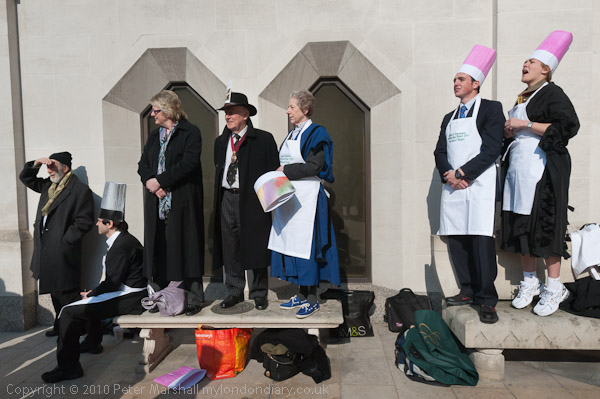
Watching the pancake races at the Guildhall
more pictures
Shrove Tuesday was marked by pancake day races in various venues around central London, all aimed at erasing money for charity.
Pancake races have taken place for some years in various parts of London. One of the older such events, at Tower Hill, did not appear to be taking place this year, despite being listed on many web sites, but there were races at Parliament, at Guildhall, in Spitalfields and on Bankside.
Certainly the most serious of such races is the annual event between three teams representing the House of Commons, the House of Lords and Parliamentary journalists, which takes place around 10am in the gardens next to the Houses of Parliament.
This year I didn't get to photograph this, but started instead at the Guildhall in the centre of the City of London. Run over a shorter course in GUildhall Yard, this is a contest between men and women from the various Guilds, both ancient and modern, and is now in its seventh year.
The event raises money for the Lord Mayor of London's appeal; this year's mayor, Alderman Michael Bear, has appealed "to provide the Bear Necessities for a generation of children and young people in the City Fringes, in London and nationwide by supporting children's charity Coram and across the world by supporting disaster relief charity RedR." You can see why there are rather a lot of bears in the pictures.
I arrived in time to he almost deafened by the starting cannon for the first heat of many; fortunately a rather smaller charge was used for the succeeding events. Being the CIty there are rules, with penalty points being docked for those not wearing the correct dress - gloves, gowns and suitable headwear, for tossing pancakes outside the prescribed areas or not at all etc. But perhaps the most interesting aspect is the competition for the best hat, although I always find the judging standard for this unsatisfactory - the best hat never wins!
Spitalfields, organised by Alternative Arts, is a much looser event, with ad-hoc teams of four, mainly from people working in the area competing for a prize, mostly in some kind of fancy dress. It's very much a fun event, although sometimes the competition gets pretty fierce. I've photographed it several years but today I just took a few pictures at the end of the event.
The newest of these events is at Bankside, immediately to the north of Southwark
Cathedral. Perhaps another year I'll take some pictures there.
more pictures
100 Years of International Women's Day
London, Tuesday 8 March 2011
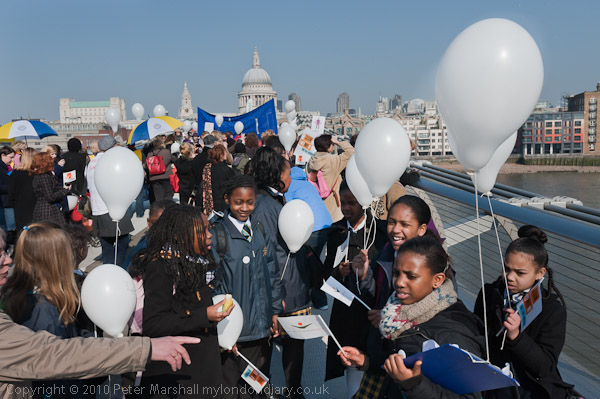
Young marchers on the Millennium Bridge
more pictures
A march following the Thames through London from Borough Market to Waterloo and a dance event, the Equals Soul Train, in Jubilee Gardens celebrated 100 years of International Women's Day.
Today's march, organised by a number of charities and involving pop starts including Annie Lennox seemed a surprisingly low-key and apolitical event with around a thousand or so woman and a few hundred men taking part. Other UK women's groups have celebrated International Women's Day annually for some years, but I don't think any of them were involved in this event.
I had expected too that it would make more of the idea of bridges which 40 other groups across the world were using in the celebrations. I had been told to expect an event of sorts on the Millennium Bridge at noon, but it happened rather earlier, when five women at the front of the march, Annie Lennox, Cherie Lunghi, Bianca Jagger, Jude Kelly and Helen Pankhurst, released white doves, although I think few people taking part in the event who were close to the front of the march actually saw it. Only around half the women were on the bridge by then, with a large crowd still on Bankside and around the bottom of the bridge. The first of my pictures does show one or even two small white blobs that could possibly be doves, but they might just have been seagulls.
Others on the march did later release rather more white balloons, as they came to the middle of the bridge, but there were never more than a few let go at any one time and it lacked any visual impact. From the south bank where I had stayed to photograph the length of the bridge full or marchers, it was certainly disappointing visually and the march seemed simply to straggle across and hang around a little before continuing on its way to a rally at the Royal Festival Hall.
The event was organised by Equals, a partnership of various charities - including Action Aid, Amnesty International, Oxfam, and other organisations including Mumsnet and the NUS and brought together by Annie Lennox. It calls for greater equality between men and women, and for a debate to begin about inequality, though it seems to define this solely in terms of equality between men and women. Although there is not argument against the generality of statistics there are very few men who for example have the power or influence or wealth of Annie Lennox. Looking at equality solely in terms of gender - vital though this is - just isn't enough.
The Equals Soul Train event later in the day at Jubilee Gardens, close to the Festival Hall, also to celebrate the 100th Anniversary of International Women's Day, also seemed rather more a promotion of the programme involving Annie Lennox, Paloma Faith and others who I have to admit I've never heard of, rather marginalising the questions around equality being promoted at the event by Action Aid.
Despite the attraction of the various music stars, there were perhaps only a couple of hundred taking part in this dance event - with almost as many photographers present for the photo call.
I didn't attend the rally, but the events I saw seemed to bear little relation to the history of International Women's Day, started by the socialist movement and in particular formulated by the German social democrat Clara Zetkin at the Second International Conference of Working Women in 1910.
The larger Million Women Rise march last Saturday
and next weekend's 'Mothers March' against cuts, poverty and discrimination
starting at noon on Saturday in Trafalgar Square seem rather more authentic
celebrations of this anniversary, and there were also other events not connected
with 'Equals' in London on the day itself.
more pictures
Around Rich Mix
Rich Mix, Bethnal Green, London. Saturday 5 March 2011
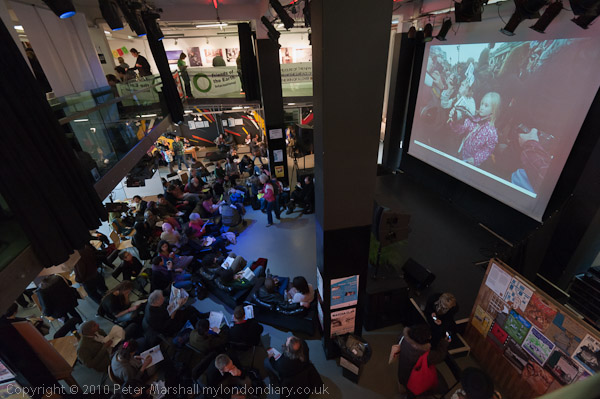 One of my pictures on screen in the bar
One of my pictures on screen in the bar
more pictures
I dropped in briefly at Rich Mix to see how my pictures looked on the screen
there, being projected with the work of two other photographers throughout
the day. I was rather disappointed to find only half of the work I had sent
being show. More about this on >Re:PHOTO,
where there is also a link to the
full set I gave them for the display.
more pictures
Million Women Rise in London
Hyde Park to Trafalgar Square, London. Saturday 5 March 2011
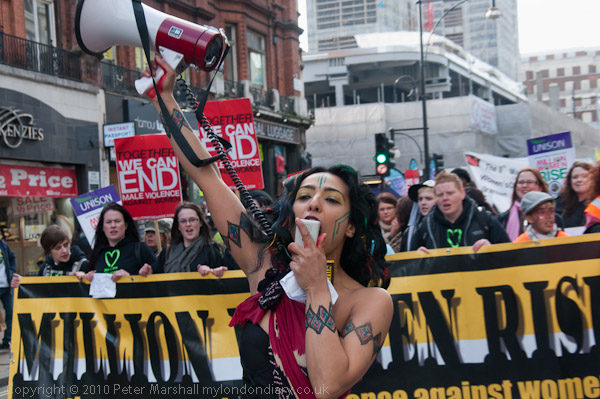
The march on Oxford St
more pictures
Several thousand women took part in the 'Million Women Rise' march through central London this afternoon calling for an end to male violence against women both in the UK and internationally.
The all-woman march set off from Hyde Park and made its way through the arch at Marble Arch onto Oxford Street. The march celebrated a hundred years of International Women's Day, proposed by German Social Democrat Clara Zetkin at the Second International Conference of Working Women in Copenhagen in 1910 and first celebrated by more than a million women and men in Austria, Denmark, Germany and Switzerland in 1911, although the movement had started in the USA a few years earlier.
The UK Million Women Rise movement held its first march in Central London in 2008 and it has become an annual event. This year it is one of more than a thousand events around the world to mark International Women's Day.
This year the atmosphere seemed rather less tense than at some previous events, and I had little problem from stewards in taking photographs. As in previous years most of those taking part were pleased to be photographed, and a quite a few recognised me from previous years and other events.
Women, and I'm sure most men also, are appalled at male violence against women, and the prevalence of domestic violence in this country. The march leaflet states that police receive on average a report of domestic violence every minute of the day, and that one woman in four will experience sexual assault as an adult. Many local authorities lack Rape Crisis Centres, and in particular specialised support services for ethnic minority women. There are 250 reported cases of forced marriage each year, around one case of so-called 'honour killing' a month and over 20,000 girls in the UK at risk of genital mutilation. Around 1400 women per year are thought to be trafficked into the UK for sexual exploitation each year, particularly from Eastern Europe.
Internationally the situation is even worse, with millions killed at or before birth because they are female, and globally around one woman dies every minute from preventable pregnancy related causes.
The Million Women Rise movement describes itself as:
"a diverse group of individual women and women representatives from the Voluntary and Community Sector who are united by our outrage at the continued daily, hourly, minute-by-minute individual and institutionalised male violence enacted against women worldwide."
They have
"no formal or informal links to any particular or specific feminist of political networks"
and the
"Coalition is not partisan and brings together women who want to highlight the continuation of all forms of violence against women and demand that steps are taken to put an end to this."
Many men, like myself, support their aims, and deplore violence and oppression in all its forms. International Women's Day started with both women and men marching together in solidarity, and I rather wish that they could do so now. But Million Women Rise say "Women have been socially, culturally and economically conditioned to defer to men, to take our lead from men, to behave in ways approved of by men. On this particular day, we want women to come and feel the strength, the exhilaration and power of being with other women, to celebrate ourselves, to sing, shout and chant at the top of our voices, in all our diversity, to demonstrate however we want because we're women in the company of other women."
There certainly was quite a lot of shouting and chanting, including the now well-known "whatever we wear, wherever we go, yes means yes and no means no" as the march went down Oxford St and shoppers stood to watch, with many showing their appreciation.
I left the march at Oxford Circus, making its way to a rally in Trafalgar
Square as I wanted to go to another event.
more pictures
Shop Stewards Urge Labour Councils to Defy Cuts
Southwark to Westminster, London. Saturday 5 March 2011
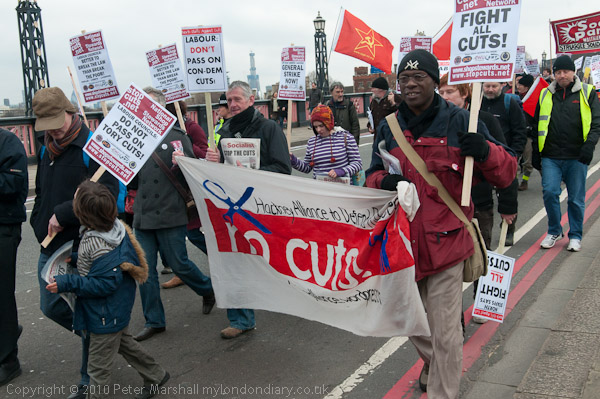
The middle of the march on Lambeth Bridge
more pictures
A march organised by the National Shop Stewards Network delivered a petition today to the Labour Local Government conference in London calling on Labour councils to defy the Lib-Con imposed cuts in public services.
Official Labour and trade union opposition to the drastic cuts imposed on local authorities by the Lib-Con coalition government has so far been at best half-hearted, with the TUC calling its demonstration for March 26, while others have been demonstrating since last October.
Many Labour run local authorities actually appear to be revelling in making massive cuts that will severely affect particularly the low paid, disabled and other vulnerable groups in society. In particular they are using them as a way to attack the power of the trade unions in local government, and worsen their working conditions and rights, Onay Kasab, a Greenwich council worker who was one of the half dozen speakers at the rally before the march, told us that all 8000 employees there were to be sacked on 1 April and be offered a new contract with inferior conditions.
Many unions also appear to be lacking any enthusiasm to oppose the cuts or even to fight for a living wage for their lower paid members, but appear to be involved with cosying up to employers and factional infighting. Kasab was one of four Unison activists, all members of the Socialist Party, who was banned from union office for four years in 2009 in what has been described as a 'witch hunt.' Following a fight the bans were imposed in March 2010, and in February this year the courts ruled that Unison had acted unlawfully in disciplining the four, banning them from office and taking control of their branches.
The protest at Labours Local government conference was organised by the NSSN and supported by many local and national trade unions and anti cuts groups including Lewisham NUT & Hackney Trades Council, and assembled at 11am at Geraldine Mary Harmsworth Park, next to the Imperial War Museum and on the boundary between Southwark and Lambeth.
Other speakers at the rally includied Rob Williams and Linda Taaffe of the National Shop Stewards Network (NSSN) which had organised the petition and lobby, Paul Brandon, the Chair of Right to Work and a Unite member and John Reid of the RMT. All who spoke urged those present to encourage as many as possible to attend the TUC organised national march on 26 March.
On the Facebook page for the event it states:
Every Labour council in Britain keeps telling us that it has ‘no choice’ but to implement the cuts – but that just isn’t true. If any council was to stop acting as collaborators with the Tory axe wielders, and instead want to stand up and fight, they would discover there were a thousand ways to defy the cuts.
The NSSN detail some of these on their Stop Cuts web site, and - as several speakers toady - mention the stands taken in previous years by Lambeth, Liverpool and Poplar councils in the past. Many councils have large reserves they could have chosen to use to reduce the effects of the cuts and the NSSN have urged Labour leader Ed Milliband to "give a lead by promising that an incoming Labour government would write off all local authority debts incurred from avoiding cuts."
So far the only powerful opposition to the cuts has come not from politicians or trade unions, but on the streets with students, organisations such as UK Uncut and the various local demonstrations, many of which have ended with short-term occupations of council chambers. But it remains to be seen if there will be a sufficiently strong public movement to force any political change.
Around 200 people, led by a samba band, carrying banners and placards, led
off down the road and over Lambeth Bridge to Smith Square where there was
a further rally before the petition was delivered to the Labour Local Government
conference in Transport House, once the Labour Party HQ but now the headquarters
of the Local Government Association.
more pictures
A Day Out at Claremont
Claremont, Esher, Surrey. Friday 4 March 2011 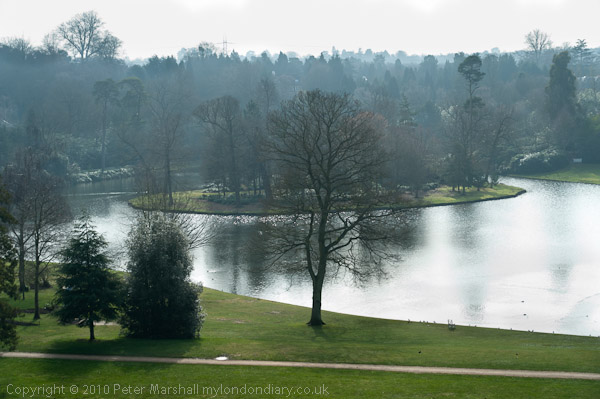
The lake at Claremont, dug in the eighteenth century.
Claremont pictures not available for commercial use.
more pictures
One of my brother-in-law's forebears, Charles McIntosh, was Head Gardener of this estate in the 1830s and showed Queen Victoria around it (it belonged to one of her family, the King of Belgium) on several occasions, both before she became queen and on one later occasion when she was accompanied by two other queens.
Quite coincidentally I found it as a young child, on one of my many bike
rides exploring Surrey and Middlesex, as a totally overgrown wildnerness covered
with rhododenrons, a secret garden with a hidden lake. Many years later it
has been cleaned up, restored to its pre-McIntosh splendour and you pay to
enter this National Trust site. More about it on >Re:PHOTO shortly.
more pictures
Health and Safety Week of Action
Old Palace Yard, London. Wednesday 2 March 2011

'We Didn't Vote to Die at Work' poster in front of Houses
of Parliament
more pictures
The Trade Union Co-ordinating Group (TUCG) which incluedes nine national unions (BFAWU, FBU, NAPO, NUJ, PCS, POA, RMT, UCU and URTU) called a Health and Safety Week of Action from 28th Feb to 5th March, and trade unionists together with other groups including Families Against Corporate Killers (FACK) came together to demonstrate outside parliament and lobby their MPs.
A couple of MPs including John McDonnell came and joined them in Old Palace Yard where I took these pictures. FACK was formed to try and get justice by the families of people killed at work, in what are termed accidents but usually arise through the failure of employers to take due regard of the safety of their employees or deliberate negligence.
Although the Health and Safety Executive (HSE) quote a figure of only 152 fatalities at work in the year ending March 2010, this grossly underestimates the true figure, omitting those killed in work-related traffic incidents, at sea, non-workers killed by work activities and those who die from occupational illnesses. The true figure for workplace deaths per year is thought to be around 1500, and a further perhaps 50,000 die from occupational diseases (around 1.3 million are thought to be suffereing from these.) As the officical UK Statistics Authority state, the "HSE does not produce an overall figure for work-related fatalities in the UK."
Only 1 in 13 of the more than 26,000 major and fatal workplace injuries per year are even investigated by the HSA, prosecutions are down by 50% compared to ten years ago. There is less regulation now than 40 years ago and the average workplace is now only inspected every 38 years. With the recently announced 35% cut in the HSE there will be even fewer inspections and prosecutions. Employers are being largely allowed to get away with criminal actions that result in people being killed and maimed.
Few workers or their families receive proper compensation for work-related illnesses injuries and deaths at work, less than 10% of those affected.
Some indication of the nature of the problem is the fact that a workplace
with trade unions and safety representatives will have only half the number
of accidents as one without, even though reporting of incidents is likely
to be much stricter. Governments and employers have largely failed in their
duty to protect workers over the years.
more pictures
top of page
All pictures on this section of the site are Copyright © Peter Marshall 2011; to buy prints or for permission to reproduce pictures or to comment on this site, or for any other questions, contact me.

